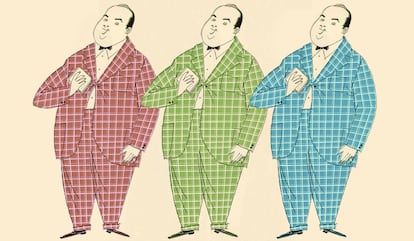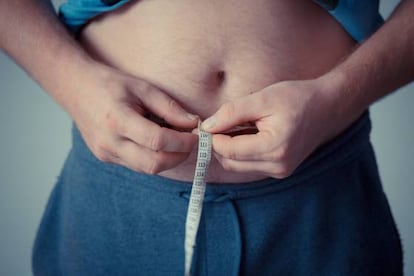Time is not the culprit: Why middle age is not responsible for middle-age spread
Are advancing years an impediment to losing weight? Are legends about the relentless metabolism true? Is exercise the answer? We tackle the mythology stored in our stomachs


The internet is brimming with supposedly infallible methods to get rid of abdominal fat and reduce your waistline in record time. Almost all of them are based on the same principle: speeding up the metabolism, a sort of biological alchemy that, in theory, can be made real via a series of tricks: giving up alcohol (almost all the miracle formulas insist on this point), developing healthy sleep habits, walking briskly for at least 30 minutes a day, controlling stress levels, moderating sugar consumption, doing aerobic exercise with some level of frequency and, believe it or not, drinking water with lemon.
However, most of these informal prescriptions contain a disclaimer: after the age of 40, the metabolism cannot be as easily accelerated. At a certain age, you are faced with a metabolic barrier: the organism, like a complacent bureaucrat, slows down hopelessly allowing fat stores to proliferate. Herculean gym sessions and an austere diet of raspberries, peas and oatmeal are no longer enough to achieve the desired result. By redoubling your efforts, you can aspire to some pyrrhic partial victory, but to all extents and purposes the war itself is lost.

The inscrutable path of the metabolism
So much for the myth of metabolic deceleration, one of the catastrophes, presumed or real, that afflict human beings as soon as they reach middle age. The good news is that it seems to be just that, a myth, but one so persistent that we have ended up turning it into a self-fulfilling prophecy: the so-called middle-age spread.
However, an August 2021 study published in the scientific journal Science that has since been cited by several media outlets showed that metabolic rate remains surprisingly stable between the ages of 20 and 60, including among women reaching menopause, the demographic group most often attributed with a “midlife expansion” due to metabolic causes. The authors of the study, based on a sample of 6,400 people from 29 different countries, said the data “shed light on human development and aging and should help shape nutrition and health strategies across the life span.” In other words, science, not myth.
James Gallagher, Health and Science correspondent for BBC News, explains that “the human body apparently goes through four distinct metabolic phases: one of accelerated metabolism in early childhood [coinciding with the initial phase of development], a mild slowdown lasting until about the end of adolescence, a long period of adult stability and, from the age of 60, a further slowdown, this time quite sharp, which is often the prelude to the diseases of old age.”
As Dr. Tom Sanders of King’s College London points out, scientific analysis suggests that at around the age of 40, “nothing particularly significant” happens in terms of metabolic rate. Drops in estrogen and testosterone levels do not cause our bodies to move into the slow lane. “Energy expenditure, which is the most reliable measure of metabolic rate, hardly decreases,” Sanders notes, so the middle-age spread cannot be attributed to this cause.
However, Sanders adds that humans do tend to put on weight at these ages: “Increasing adiposity — i.e., the increased tendency to generate fat deposits — is a well-documented phenomenon in the fifth decade of life.” The latest scientific evidence does not dispute this, but points to other causes.

Other lines of investigation
According to Sara Novak, a contributing writer for New Scientist magazine, once the false culprit has been ruled out, it is time, as in Casablanca, to round up the usual suspects again. That ring of fat around the belly or abdomen that some have dubbed “the other curve of happiness” is due, says Novak, to “the [almost] usual: bad habits such as lack of exercise and poor diet.”
Nothing abnormal happens to our metabolism. In most cases, it maintains its capacity to respond, so shifting extra weight is as easy in metabolic terms at 45 as it is at 25. What is perhaps more complicated, in Novak’s opinion, is “adopting a healthy lifestyle at times when both daily inertia and the deep-rootedness of bad habits conspire to prevent us from doing so.” Rather than metabolic deceleration, one could point to accelerated lifestyles and human beings tired of so much hustle and bustle. According to Sanders, it can be argued that the “obesity epidemic” occurring among the over-40s in developed nations “is driven by excessive dietary energy consumption and a parallel reduction in energy expenditure.”
Another suggestive line of interpretation, complementary to the previous one, establishes a connection between the two curves of happiness: the emotional one and the one that makes us unable to squeeze into our own pants. A study conducted by the British economist David G. Blanchflower, of Dartmouth University in the United States, established that the degree of subjective happiness of a person depends, to a large extent, on age. Based on responses from a large sample of people from 145 countries, 109 of them developed nations, Blanchflower established that the zenith of happiness is reached in early childhood and begins to wane as soon as puberty begins. As we get older, perceived happiness declines until it reaches its lowest ebb, the mood nadir, which occurs at around age 47. Then, as counterintuitive as it may seem, life satisfaction levels tend to rebound, eventually forming a U-shaped graph.
Based on Blanchflower’s study, midlife expansion could be attributed to psychological causes. Perhaps we put on weight because we are unhappy. Because our self-preservation instinct and our emotional attachment to life have weakened. Because we are slapped in the face by reality, we settle into a diffuse dissatisfaction and feel less inclined to develop a healthy lifestyle. Novak agrees that “a certain degree of unhappiness or life dissatisfaction” may be one of the reasons why many of those entering middle age develop comparatively unhealthy lifestyles.
Better on the hips than in the pancreas
The issue can, however, be examined from a more flattering point of view. Midlife expansion need not necessarily be a negative phenomenon. After all, a narrower body is not preferable in every and all circumstances. A January 2022 article in The Guardian provides a refreshing point of view by noting that some types of horizontal expansion or even moderate obesity can actually be beneficial to health.
Ultimately, it all depends on where the fat is stored. Better under the skin, even if it is much more visible, than in the liver or pancreas. Body mass index does not tell the whole story. Certain levels of properly distributed adiposity can be healthy. Of course, one does not choose in which parts of one’s body fat accumulates. Dr. Hanieh Yaghootkar, author of one of the leading studies on the subject, points out that this crucial detail depends, as does almost everything else in life, “on the genetic lottery.”
The Guardian article concludes, with corrosive humor, that “larger societal forces” may be at work to explain middle-age spread, but also points to the fact that the phenomenon cannot be attributed to any perverse conjuring of the metabolism and that, in any case, it is advisable to consider trimming down. How? Well, with a fibrous diet, long walks at Olympic speeds, non-alcoholic beer, water with lemon and a little dose of happiness. And, preferably, no excuses.
Sign up for our weekly newsletter to get more English-language news coverage from EL PAÍS USA Edition
Tu suscripción se está usando en otro dispositivo
¿Quieres añadir otro usuario a tu suscripción?
Si continúas leyendo en este dispositivo, no se podrá leer en el otro.
FlechaTu suscripción se está usando en otro dispositivo y solo puedes acceder a EL PAÍS desde un dispositivo a la vez.
Si quieres compartir tu cuenta, cambia tu suscripción a la modalidad Premium, así podrás añadir otro usuario. Cada uno accederá con su propia cuenta de email, lo que os permitirá personalizar vuestra experiencia en EL PAÍS.
¿Tienes una suscripción de empresa? Accede aquí para contratar más cuentas.
En el caso de no saber quién está usando tu cuenta, te recomendamos cambiar tu contraseña aquí.
Si decides continuar compartiendo tu cuenta, este mensaje se mostrará en tu dispositivo y en el de la otra persona que está usando tu cuenta de forma indefinida, afectando a tu experiencia de lectura. Puedes consultar aquí los términos y condiciones de la suscripción digital.
More information
Archived In
Últimas noticias
Millennia-old Yuracaré language resists extinction through 900 speakers and a new dictionary
Susan Boyle prepares a comeback just as Timothée Chalamet sings her praises
Trump suspends green card visa lottery after shooting at Brown University
When things get out of hand at the lab: Hundreds of accidents expose the ‘catastrophic’ risk of dangerous pathogen leaks
Most viewed
- Christian Louboutin: ‘Young people don’t want to be like their parents. And if their parents wear sneakers, they’re going to look for something else’
- Cartels in Mexico take a leap forward with narco-drones: ‘It is criminal groups that are leading the innovation race’
- Liset Menéndez de la Prida, neuroscientist: ‘It’s not normal to constantly seek pleasure; it’s important to be bored, to be calm’
- ‘El Limones’ and the growing union disguise of Mexican organized crime
- The low-cost creative revolution: How technology is making art accessible to everyone










































